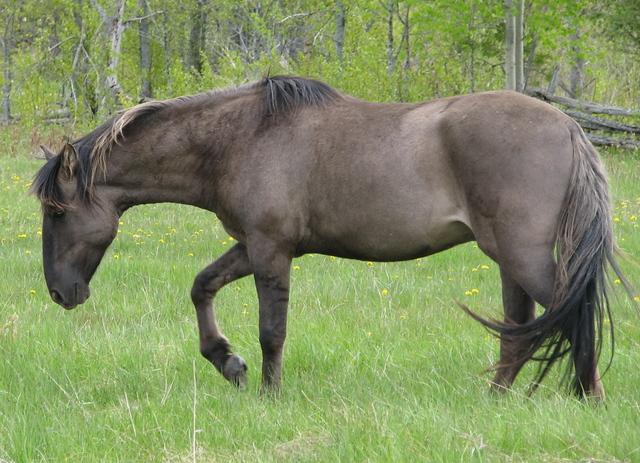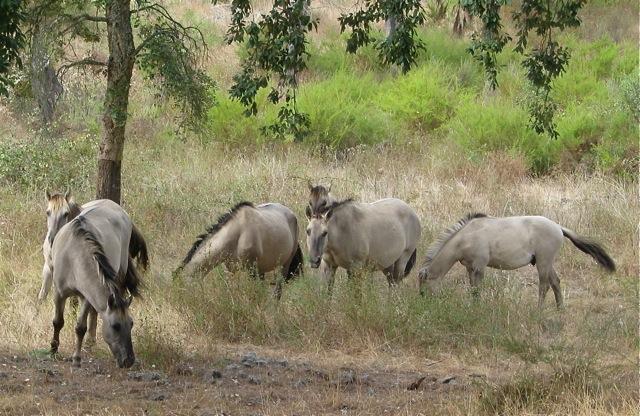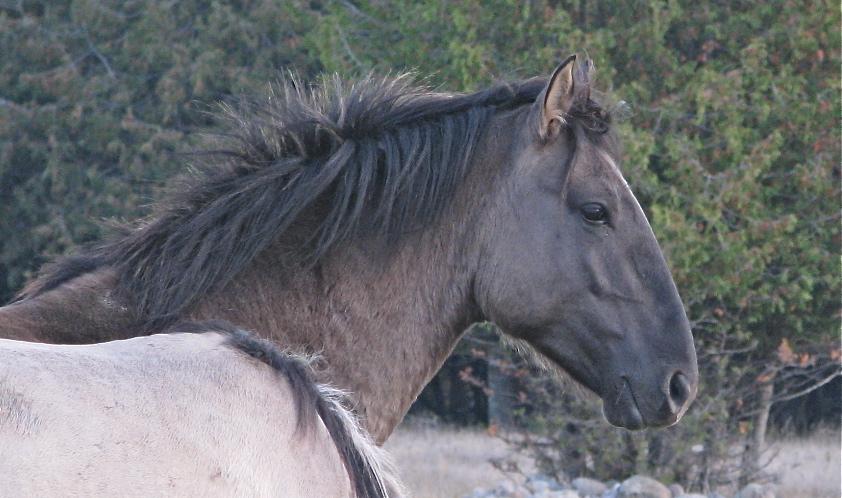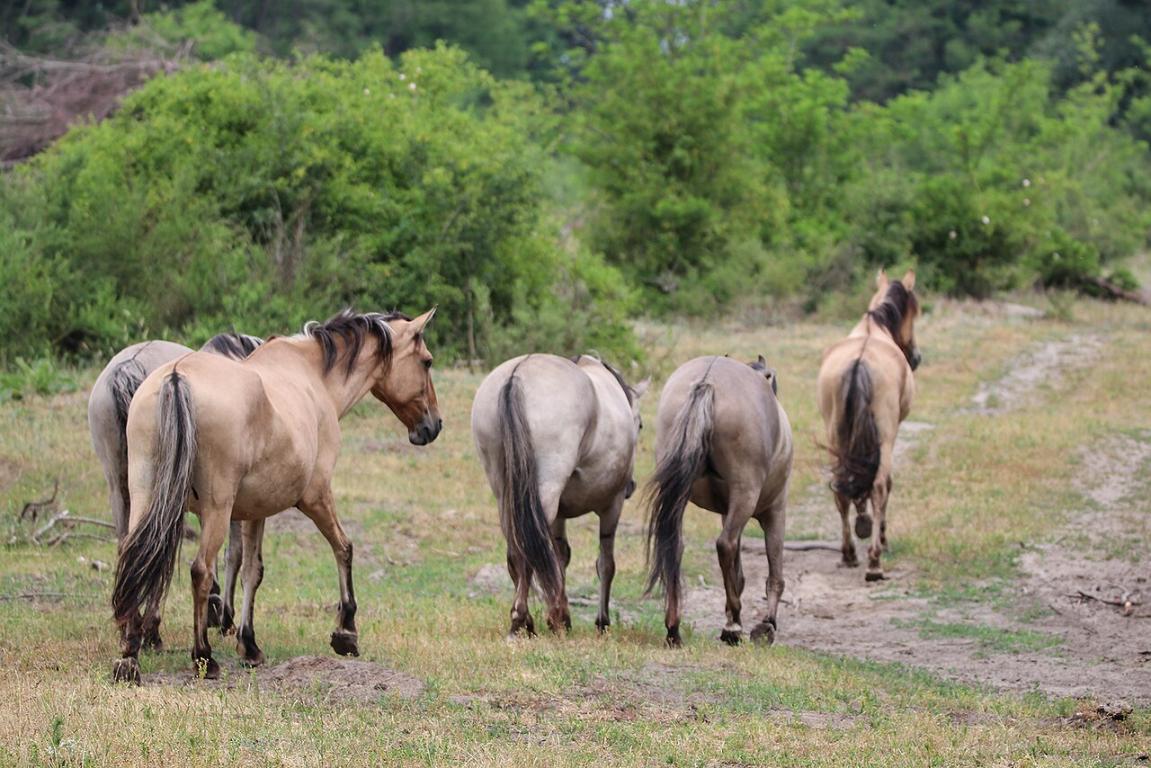
Continent: Europe
Country: Portugal
Weight: 360 – 400 kg
Height: 135 – 150 cm



The Sorraia is a primitive breed native to southern Portugal, mainly in the valley of the Sorraia River (a tributary of the Tagus), from which it takes its name. Historically, it was found in the regions of Ribatejo and Alentejo, areas of plains and pastures that shaped its hardiness.
This horse is considered a direct descendant of the wild Iberian equine populations. Its morphological features (grullo or dun coat, dorsal stripe, leg barring) strongly resemble the horses depicted in the Paleolithic cave art of the Iberian Peninsula.
Several small farms scattered across central and southern Portugal, still under the authority of the stud-book (Associação Internacional para a Preservação e Proteção do Cavalo Sorraia). Conservation in semi-feral conditions in nature reserves, notably in the Tagus valley.
To secure the survival of the breed, herds of Sorraia have been introduced abroad:
The Sorraia is therefore bred mainly in Portugal, but its survival depends on an international network of committed breeders working on the conservation of primitive horses.
The Sorraia is considered one of the last living representatives of the primitive Iberian horses. Its morphological traits grullo or dun coat, dorsal stripe, leg barring testify to a very ancient origin, close to that of the horses depicted in Paleolithic cave art of the Iberian Peninsula.
Studied by geneticists, the Sorraia is a living model of an archaic horse. Its preservation helps in better understanding the evolution of European domestic horses. It is recognized by the FAO as an endangered genetic resource, which gives it significant heritage value.
The Sorraia has remarkable endurance, frugal feeding habits, natural resistance to diseases, and adaptation to poor environments. These qualities make it a precious genetic reservoir to strengthen the hardiness and robustness of other modern horse breeds.
Some specialists believe that the Sorraia influenced the formation of Iberian breeds such as the Lusitano and the Andalusian, as well as several lines of Mustangs introduced to America by the Spanish colonists. It is therefore an essential genetic link between the ancient Iberian horses and certain current equine populations.
The Sorraia is considered a direct descendant of the wild Iberian horses, present in the peninsula since prehistoric times. Its primitive features (grullo or dun coat, dorsal stripe, leg barring) recall those of the horses represented in the Paleolithic cave art found in Portugal and Spain.
For centuries, the Sorraia survived in a semi-feral state in the plains of Ribatejo and Alentejo, especially along the Sorraia River valley. This geographical isolation allowed it to preserve a unique genetic heritage, without being massively influenced by crossbreeding practiced elsewhere in Europe.
In the early 20th century, the Portuguese zoologist Ruy d’Andrade (1880–1967) identified the Sorraia as a distinct equine group, close to prehistoric horses. Aware of its value, he initiated a preservation program, gathering typical specimens to ensure reproduction and recognition.
Thanks to conservation efforts, the breed was gradually recognized in Portugal and abroad. In the second half of the 20th century, some Sorraia were exported to Germany and the United States, where breeders continued the preservation work. Today, although its numbers remain low, the Sorraia enjoys international scientific recognition as a rare primitive breed and a living witness of Iberian equine history.
The Sorraia is known for its lively and energetic character, a legacy of its semi-feral origins. Intelligent and reactive, it can sometimes be wary of humans, but gains confidence with patient and respectful handling.
Accustomed to surviving in harsh environments, the Sorraia has a strong preservation instinct. It can find food on difficult terrain and withstand extreme climates, making it a self-sufficient and enduring horse.
The Sorraia is a very social horse, strongly attached to herd life. In its natural habitat, it establishes a clear hierarchy, with cohesion and collective vigilance. This gregarious instinct strengthens its ability to adapt to semi-feral management and rewilding projects.
Although sometimes seen as stubborn or independent, the Sorraia proves to be loyal and hardworking once trust is established. It appreciates calm interactions and becomes a reliable partner in light activities (hiking, leisure driving, equestrian tourism). Its sensitivity, however, requires an experienced and respectful rider.
“The Sorraia embodies the wild pride of Iberia: independent, hardy, and faithful to those who earn its trust.”
The Sorraia remains a threatened breed, with a global population limited to a few hundred individuals. Conservation programs in Portugal and in some European countries (notably Germany) aim to maintain genetic diversity and avoid inbreeding. Controlled breeding plans are essential to ensure the survival of this primitive lineage.
As a genetic relic of the primitive Iberian horse, the Sorraia attracts the attention of scientists and ecologists. It is increasingly used in rewilding projects, where its hardiness and adaptability make it an asset for the ecological management of natural areas.
Although deeply rooted in its region of origin, the breed enjoys growing international interest, especially thanks to passionate breeders in Germany, the United States, and Canada. This diffusion contributes to securing the future of the Sorraia by diversifying its breeding bases.
With the rise of equestrian tourism and the promotion of living heritage, the Sorraia could become a symbol of Portuguese biodiversity. Its image as a primitive and rare horse is increasingly appealing to the public and opens perspectives in environmental awareness and cultural promotion.
The Sorraia is an extremely hardy breed, shaped by centuries of semi-feral life in poor environments. It has good longevity, natural resistance to diseases, and remarkable adaptation to varying climates.
Its hard and well-shaped hooves allow it to move without shoes on rough terrain. Problems such as laminitis or hoof fragility are rare, provided it maintains regular activity and an adapted diet.
Accustomed to a frugal diet, the Sorraia can be sensitive to dietary excesses. Too much grain or rich feed may cause digestive disorders or overweight, which can harm its joints.
With a population reduced to a few hundred individuals worldwide, the breed faces a risk of inbreeding. Conservation programs aim to mitigate this genetic fragility by diversifying breeding lines.
The Sorraia enjoys better health in extensive conditions, living in pasture or semi-feral systems. It does poorly in confined environments or with prolonged inactivity, which may affect its locomotor system and psychological balance.